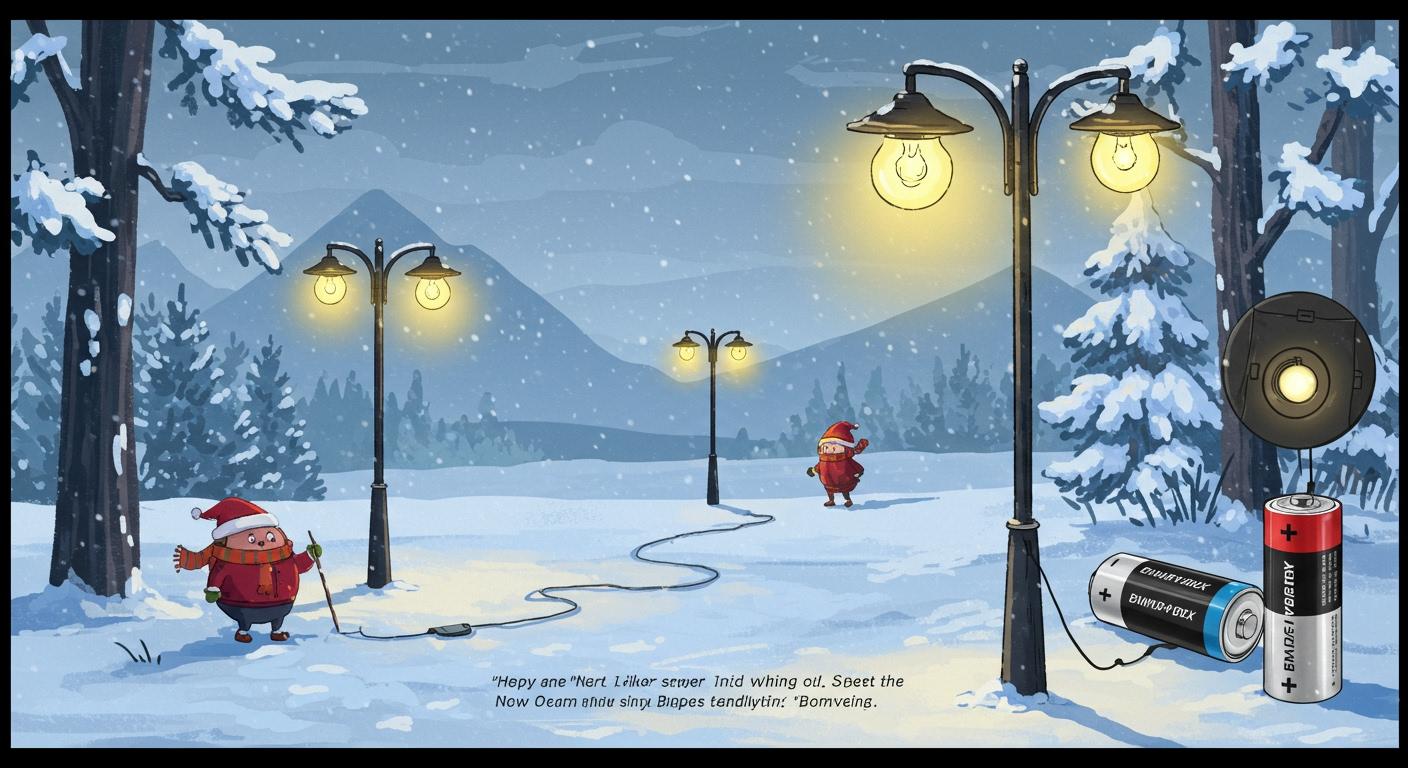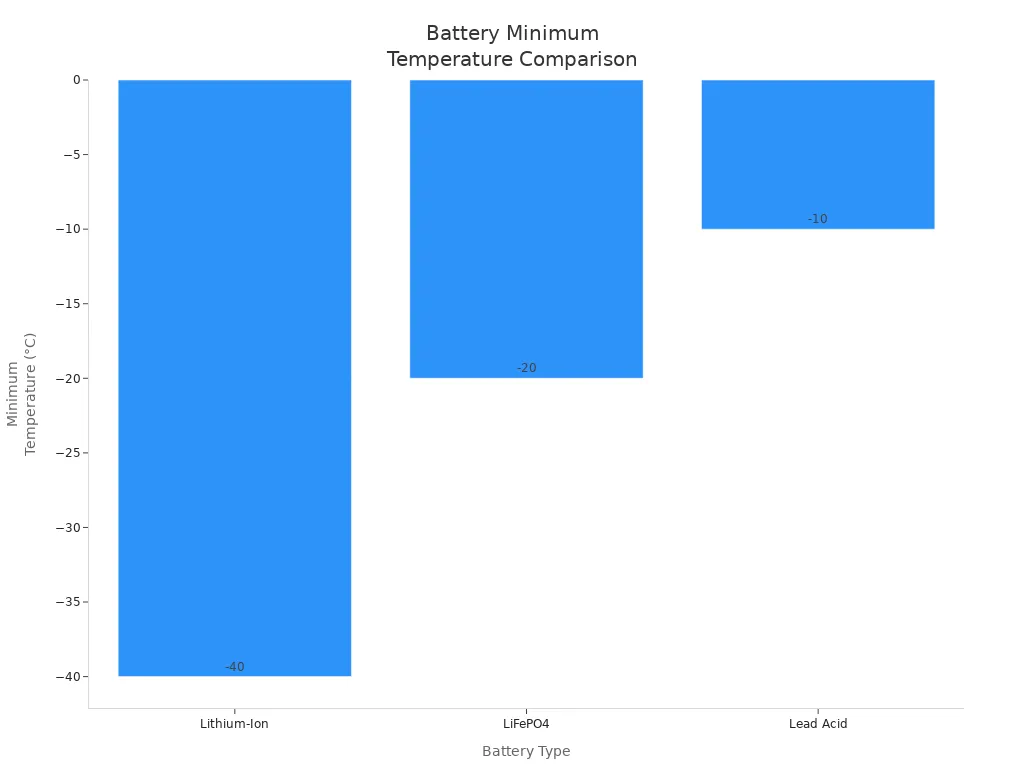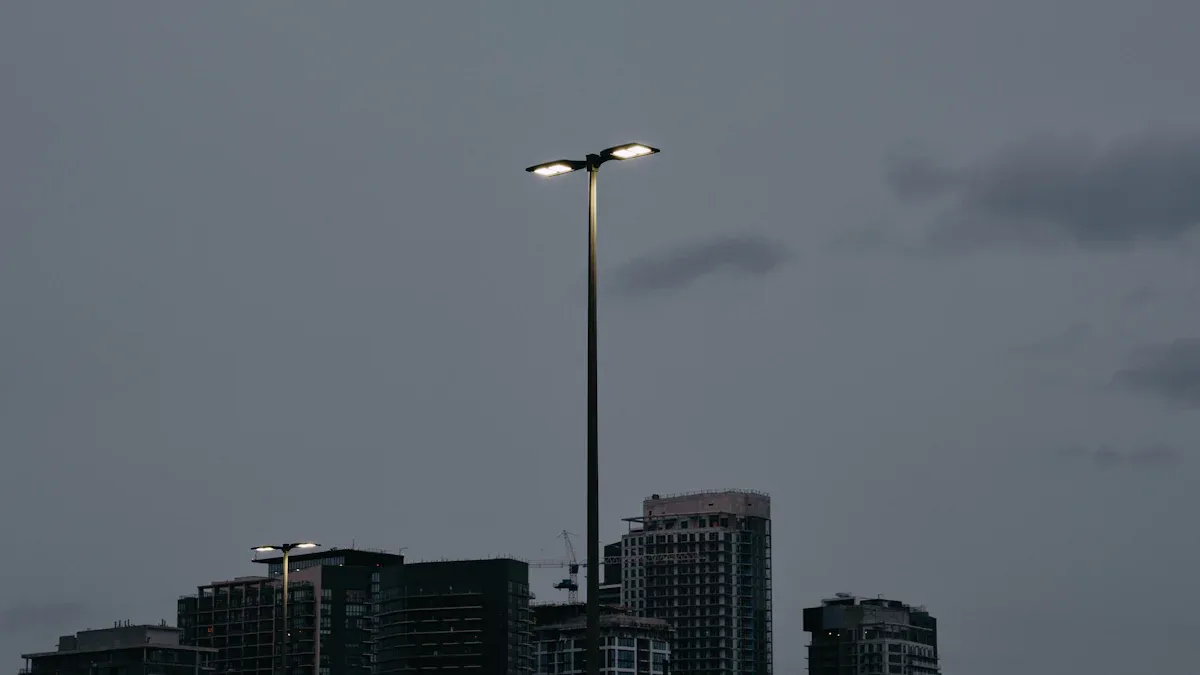
When you need reliable outdoor lighting in extreme cold, LiFePO4 battery technology stands out as the Best Battery Solutions. LiFePO4 batteries maintain about 50% performance at -20°C, while lead-acid options lose much more capacity and risk damage from freezing. You see true value in choosing batteries that perform efficiently across a wide range, from -20°C up to 60°C.
Many believe all batteries work the same in cold weather, but that is not accurate.
Misconception | Clarification |
|---|---|
All batteries perform the same in cold | Lead-acid batteries can lose up to 50% capacity at -18°C, while lithium batteries retain more power. |
By understanding these facts, you put your outdoor lighting projects on a path to consistent performance, even in harsh winter environments.
Key Takeaways
LiFePO4 batteries excel in extreme cold, maintaining about 80% capacity at -20°C, ensuring reliable outdoor lighting.
AGM and lead-acid batteries struggle in cold weather, losing significant capacity and risking damage, making them less suitable for harsh climates.
Choose batteries with self-heating technology for safe charging in freezing temperatures, enhancing performance and longevity.
Regular maintenance and proper installation of batteries and solar panels maximize efficiency and runtime in outdoor lighting systems.
Investing in high-quality lithium batteries reduces long-term costs and environmental impact due to their longer lifespan and lower replacement frequency.
Part1: Best Battery Chemistries

Choosing the right batteries for outdoor lighting in extreme cold is critical for reliable performance. You need to understand how different battery chemistries behave when temperatures drop far below freezing. This section compares the most common options for outdoor lighting, focusing on safety, stability, and efficiency.
1.1 LiFePO4 Batteries
LiFePO4 batteries set the standard for cold-weather outdoor lighting. You benefit from their excellent safety profile and stable performance, even in harsh winter conditions. These batteries maintain high capacity at low temperatures, which means your lighting systems stay bright and dependable.
Advantage | Description |
|---|---|
Thermal Stability | LiFePO4 batteries have inherent thermal stability, reducing risks in cold climates. |
Lower Risk of Thermal Runaway | Compared to other chemistries, LiFePO4 batteries have a significantly lower risk of thermal runaway. |
Effective Thermal Management | They can incorporate thermal management systems to mitigate cold weather impacts effectively. |
You can see that LiFePO4 batteries retain over 80% of their capacity at -20°C. For example, a 100Ah LiFePO4 battery can still deliver 80Ah at this temperature. These batteries also maintain stable voltage under load, so your lighting does not flicker or dim unexpectedly. Many industries, such as municipal infrastructure, commercial real estate, and remote industrial sites, rely on lithium battery packs for these reasons.
Tip: Large Power’s low-temperature LiFePO4 batteries can be safely charged at -20°C and discharged at -40°C. Equipped with advanced BMS, they deliver reliable performance and enhanced safety even in extreme cold climates.
1.2 AGM Batteries
AGM (Absorbent Glass Mat) batteries are a type of lead-acid battery designed for improved safety and reduced maintenance. However, you will notice significant performance drops in extreme cold. AGM batteries can lose 40-60% of their capacity below freezing. For instance, two 6V AGM batteries with a combined 200Ah rating may only provide 100Ah at -20°C.
LiFePO4 batteries show better resilience in cold temperatures compared to AGM batteries, retaining a higher usable capacity.
AGM batteries encounter significant capacity loss below 32°F (0°C), while LiFePO4 performs better under similar conditions.
AGM batteries experience significant voltage sag under load in cold conditions, while LiFePO4 maintains stable voltage.
LiFePO4 batteries can discharge effectively at temperatures as low as -20°C, unlike AGM batteries which suffer considerable capacity reduction below 0°C.
You may find AGM batteries suitable for moderate climates, but they do not match the cold-weather performance of lithium battery packs.
1.3 Lead-Acid Batteries
Traditional lead-acid batteries remain common in outdoor lighting, but they struggle in extreme cold. Their minimum operating temperature is much higher than that of lithium-based batteries. The following table shows how different battery types perform in cold weather:
Battery Type | Cold Weather Performance | Minimum Temperature |
|---|---|---|
Lithium-Ion | Excellent | -40°F (-40°C) |
LiFePO4 | Very Good | -4°F (-20°C) |
Lead Acid | Fair | 14°F (-10°C) |

Lead-acid batteries can freeze and lose up to 50% of their capacity at -18°C. This makes them unreliable for outdoor lighting in regions with harsh winters. Their shorter lifespan also leads to more frequent replacements, increasing environmental impact and operational costs. You should consider lithium battery packs for better sustainability and reduced waste. For more on sustainability and conflict minerals, see our internal resources.
Note: Alkaline batteries are not suitable for outdoor lighting in extreme cold. Their performance drops sharply as temperatures fall, and they risk leakage or internal damage below -18°C. Lithium batteries are a more reliable alternative for these conditions.
Part2: Performance Comparison
2.1 Cold Weather Efficiency
You need outdoor lighting that works in the harshest conditions. Cold weather affects the efficiency of all batteries, but not equally. Here is how the main types compare:
LiFePO4 batteries keep high capacity and stable performance in low temperatures. Their chemical structure resists freezing.
Lead-acid batteries lose efficiency quickly. The electrolyte can freeze, which damages the battery and lowers capacity.
AGM batteries resist freezing better than standard lead-acid, but still lose performance in very low temperatures.
Battery Type | Capacity at 0°F (−18°C) | Cold Weather Efficiency | High Capacity Retention |
|---|---|---|---|
LiFePO4 | 60% | Excellent | Yes |
AGM | 50% | Moderate | No |
Lead-Acid | 45% | Poor | No |
You see that LiFePO4 solar light batteries outperform others in cold climates. This means your solar lighting systems will have longer runtime and higher reliability.
2.2 Discharge and Charge Rates
Discharge and charge rates affect how well your solar light batteries power your lighting and how quickly they recharge. LiFePO4 batteries support charge and discharge rates from 0.5C to 1C, which gives you flexibility for high-demand applications. Lead-acid batteries have lower rates and struggle in cold weather. Charging LiFePO4 batteries below freezing can cause lithium plating, so you should use models with self-heating features, such as RELiON LT Series or LiTime self-heating batteries, for safe operation.
LiFePO4 batteries: 0.5C–1C charge/discharge rates, high capacity, but need care below 0°C.
Lead-acid batteries: Lower rates, lose capacity quickly in cold, not ideal for solar lighting.
AGM batteries: Slightly better than lead-acid, but still not optimal for extreme cold.
2.3 Cycle Life
Cycle life measures how many times you can charge and discharge a battery before it loses high capacity. In extreme cold, LiFePO4 batteries may reach about 300 cycles. This is lower than in warm climates, but still better than most lead-acid options. You get more longevity and durability from high-quality batteries designed for solar lighting.
2.4 Safety and Reliability
Cold-weather lithium batteries, such as RELiON LT Series and LiTime self-heating models, offer advanced safety features:
Feature | Description |
|---|---|
Safe Charging Temperature | Charges safely down to -20°C (-4°F) |
Proprietary Heating Tech | Uses charger power for heating, no extra parts needed |
Ingress Protection (IP67) | Resists dust and water, works in tough outdoor conditions |
Eco-Friendly | No hazardous gases, supports sustainability and clean energy |
You ensure reliable solar lighting by choosing rechargeable batteries for solar lights with these features. This protects your investment and supports sustainability goals.
Part3: Best Battery Solutions for Outdoor Lighting
3.1 Best Solar Light Batteries
You need the best solar light batteries to ensure reliable outdoor lighting in extreme cold. Industry experts recommend several high-performance options for subzero environments. These batteries deliver consistent capacity, high efficiency, and long runtime, even when temperatures drop far below freezing.
RELiON LT Series: This lithium iron phosphate (LiFePO4) battery features self-heating technology. It charges safely in cold weather and maintains high capacity for outdoor solar lights.
LiTime Cold-Weather Batteries: These LiFePO4 batteries offer advanced low-temperature protection. You get stable performance and extended battery longevity in harsh climates.
Tenergy LiFePO4: With over 1,000 charge cycles, this battery is designed for harsh weather. It is ideal for high-efficiency solar lights and outdoor applications.
Linkind Smart Solar Spotlight SL5C: This product uses LiFePO4-grade resilience and delivers more than 14 hours of runtime in subzero temperatures. MPPT-enhanced charging improves solar energy capture for longer light output.
You can also consider replacing traditional batteries with supercapacitors, such as the greencap 100F supercap. When you enclose these in a glass jar, you protect the circuit from moisture and snow, which extends the lifespan of your solar lights.
Tip: Choose solar light batteries that support advanced battery management systems (BMS). These systems help you monitor battery health and maximize efficiency in outdoor environments.
3.2 Rechargeable Batteries for Solar Lights
Rechargeable batteries for solar lights must withstand extreme temperatures and frequent cycling. LiFePO4 batteries stand out as the best battery solutions for outdoor solar lights in cold climates. You benefit from their exceptional cycle life and stable performance.
LiFePO4 batteries operate in temperatures from -20°C to 60°C. This wide range ensures your outdoor solar lights work year-round.
These batteries last 3-5 times longer than traditional NiMH batteries. You reduce replacement costs and improve battery longevity.
LiFePO4 batteries maintain high capacity and efficiency in both cold and hot weather. You get reliable light output and longer runtime.
Compared to NiMH and standard li-ion batteries, LiFePO4 batteries offer better durability and lifespan. This makes them a valuable investment for outdoor lighting projects.
Battery Type | Temperature Range (°C) | Typical Cycle Life | High Capacity Retention | Suitable for Extreme Cold |
|---|---|---|---|---|
LiFePO4 | -20 to 60 | 2,000+ | Yes | Yes |
NiMH | 0 to 50 | 500–1,000 | No | No |
NiCad | Below -30 | 1,000+ | Moderate | Yes (with limitations) |
Lead-Acid | -10 to 40 | 300–500 | No | No |
You should select rechargeable batteries for solar lights that match your region’s climate and your project’s runtime needs. For more information on responsible sourcing, see our conflict minerals statement.
3.3 Outdoor-Rated Battery Features
Outdoor-rated batteries must deliver reliable performance and high capacity in extreme cold. You should look for several key features when choosing the best battery solutions for outdoor lighting:
Self-Heating Technology: This feature allows batteries to charge safely at low temperatures. RELiON LT Series and LiTime cold-weather batteries use this technology to maintain efficiency and capacity.
Low-Temperature Protection: Advanced BMS and thermal management systems protect batteries from damage during freezing conditions. You ensure longer battery life and consistent light output.
Corrosion-Resistant Casings: Outdoor solar lights face moisture, snow, and dust. Batteries with corrosion-resistant and waterproof casings prevent damage and extend lifespan.
Wide Temperature Tolerance: Select batteries that operate from -20°C to 60°C. This range covers most outdoor environments and ensures high-efficiency solar lights work in all seasons.
High Capacity and Runtime: Choose batteries with high capacity ratings. You get longer runtime and brighter light for your outdoor solar lights.
Feature | Benefit for Outdoor Solar Lights |
|---|---|
Self-Heating | Safe charging and discharging in cold weather |
Low-Temperature Protection | Prevents capacity loss and battery damage |
Corrosion Resistance | Extends battery life in harsh environments |
Wide Temperature Range | Reliable performance in all seasons |
High Capacity | Longer runtime and brighter light |
Note: Cold temperatures can reduce battery capacity and performance. Lead-acid batteries may lose 30-60% of their power in extreme cold, while LiFePO4 batteries maintain charge and output. For the best results, use insulation methods and select battery types engineered for cold weather.
Part4: Maximizing Battery Performance
4.1 Installation Tips
You can improve the performance and longevity of batteries in outdoor solar lights by following proven installation practices.
Pre-winter conditioning helps stabilize chemical performance. Charge batteries fully before the first freeze.
Store spare batteries indoors during extreme temperatures to prevent capacity loss.
Monthly maintenance keeps solar panels clean and ensures optimal efficiency.
After snowstorms, remove snow from panels and inspect for damage.
Tip: Proper installation and regular checks help maintain runtime and efficiency for outdoor solar lights in harsh climates.
4.2 Thermal Management
Thermal management plays a key role in maintaining battery efficiency for outdoor solar lights.
Battery thermal management systems (BTMS) allow heating to keep batteries within optimal temperature ranges.
Insulation techniques help maintain battery temperature and efficiency.
Passive cooling uses heat sinks and insulation for natural heat dissipation.
Active cooling methods, such as liquid or air cooling, actively remove heat from batteries.
Thermal management systems use sensors and algorithms to monitor and control battery temperature.
Note: Effective thermal management ensures batteries deliver consistent light output and efficiency for outdoor solar applications.
4.3 Charging in Cold Weather
Charging protocols for lithium battery packs in outdoor solar lights require careful attention during cold weather.
Allow batteries to warm up to room temperature before charging. Low temperatures slow electrochemical processes and extend charging times.
When charging below freezing, reduce the charge current to prevent damage.
The table below shows recommended charging rates:
Temperature Range (°F) | |
|---|---|
32 to 14 | 0.1 |
14 to -4 | 0.05 |
Charging lithium batteries at low temperatures requires limiting the charge current to 5-10% of battery capacity. This protects battery health and ensures reliable runtime for outdoor solar lights.
4.4 Maintenance Best Practices
Regular maintenance extends the lifespan and efficiency of batteries in outdoor solar lights.
Pre-winter conditioning stabilizes chemical performance.
Store spare batteries indoors during extreme cold snaps to prevent irreversible capacity loss.
Inspect solar panels and batteries monthly for damage or dirt.
Replace batteries showing reduced capacity or runtime.
Clean solar panels to maximize light absorption and efficiency.
Consistent maintenance ensures outdoor solar lights deliver reliable performance and longevity, even in extreme temperatures.
Part5: Application Scenarios

5.1 Commercial Lighting
You rely on advanced lithium battery packs for commercial outdoor lighting projects. These batteries power solar lights in parking lots, business campuses, and retail centers. LiFePO4 batteries deliver consistent efficiency and high capacity, even when outdoor temperature drops below freezing. Many commercial sites in Massachusetts and Minnesota use solar lights with LiFePO4 batteries to ensure reliable light output during winter. The table below shows common commercial applications:
Application Type | Description |
|---|---|
Solar Street Lights | Power solar lighting systems, including street, pathway, and area lights, ensuring consistent performance in cold climates. |
Cold Climate Adaptability | Rechargeable LiFePO4 batteries can be used in cold climates, with proper management of charging temperatures to avoid issues. |
Real-world Examples | Successful installations in Massachusetts and other cold areas demonstrate reliability and performance in extreme conditions. |
You see that solar lights with these batteries maintain runtime and efficiency, even in extreme temperatures.
5.2 Municipal Projects
Municipalities choose lithium battery packs for outdoor solar lights in parks, roadways, and public spaces. These batteries offer high energy density and longer cycle life, which reduces maintenance costs. You benefit from lower self-discharge rates, so solar lights stay ready for use. Municipal projects in cold regions prefer LiFePO4 batteries because they operate effectively in low temperatures. Consider the following factors when selecting batteries for municipal solar lighting:
High energy density
Longer cycle life
Lower self-discharge rate
Municipalities often evaluate cost, performance requirements, and environmental considerations before choosing batteries for solar lights.
5.3 Industrial Sites
Industrial sites require outdoor solar lights that work reliably in harsh environments. You face challenges with capacity loss and charging efficiency at low temperatures. LiFePO4 batteries maintain performance and provide a long-lasting power source for outdoor electronics, such as security systems and robotics. These batteries ensure that solar lights and other devices function without frequent replacements. In Minnesota, solar lights with LiFePO4 batteries continue to operate efficiently, even when temperatures drop below -10°C. Gel lead-acid batteries struggle in these conditions, but lithium battery packs deliver superior efficiency and longevity.
LiFePO4 batteries maintain capacity and performance in cold conditions.
They provide reliable power for outdoor lighting, security, and industrial automation.
5.4 Remote and Off-Grid Locations
You often deploy solar lights in remote or off-grid locations, such as infrastructure sites, transportation hubs, and medical facilities. Winter brings short days, low sun angles, and snow coverage, which challenge solar light efficiency. You can solve these issues by using larger solar panels and higher capacity batteries. Regular maintenance, such as cleaning solar panels and checking battery levels, keeps your solar lights running smoothly. The table below outlines common challenges and solutions:
Challenges | Solutions |
|---|---|
Short days | Use larger solar panels |
Low sun angles | Use higher capacity batteries |
Snow coverage affecting efficiency | Regular maintenance like cleaning solar panels |
You ensure reliable light output and maximize runtime by selecting the right batteries and maintaining your solar lights, even in extreme temperatures.
You gain the most reliable outdoor lighting in extreme cold by choosing LiFePO4 batteries. These batteries deliver higher efficiency, longer lifespan, and greater safety than lead-acid options, as shown below:
Battery Type | Performance at 0°F | Lifespan | Cost Implications |
|---|---|---|---|
Lithium | 70% of capacity | Longer lifespan | Higher initial cost, long-term savings |
Lead-Acid | 45% of capacity | Shorter lifespan | Lower initial cost, frequent replacements |
Select outdoor-rated, cold-weather batteries to ensure your light operates year-round. Regular inspections and proper installation maximize performance. For the latest advancements, consult trusted suppliers specializing in cold-weather lithium battery packs.
FAQ
What makes LiFePO4 batteries the best choice for outdoor lighting in extreme cold?
You get superior safety, stability, and performance with LiFePO4 batteries. These batteries maintain high capacity at low temperatures. Industries like municipal infrastructure and industrial sites rely on them for reliable outdoor lighting.
Learn more about battery management systems (BMS).
How do LiFePO4 batteries compare to lead-acid batteries in cold weather?
Battery Type | Capacity at -20°C | Cycle Life | Maintenance |
|---|---|---|---|
LiFePO4 | ~80% | 2,000+ | Low |
Lead-Acid | ~50% | 300–500 | High |
You see longer life and better cold-weather performance with LiFePO4 batteries.
Can you charge lithium battery packs safely in freezing temperatures?
You should use special purpise lithium battery packs, such as Large Power Low Temperature Series. These batteries allow safe charging below 0°C.
Tip: Always follow manufacturer guidelines for charging in cold environments.
What features should you look for in outdoor-rated lithium battery packs?
You need self-heating technology, low-temperature protection, corrosion-resistant casings, and a wide temperature range (-20°C to 60°C).
These features ensure reliable performance for solar lighting in commercial, municipal, and industrial applications.
How do lithium battery packs support sustainability in outdoor lighting projects?
You reduce waste and environmental impact by choosing lithium battery packs with long cycle life.
See our approach to sustainability and conflict minerals statement for more details.




